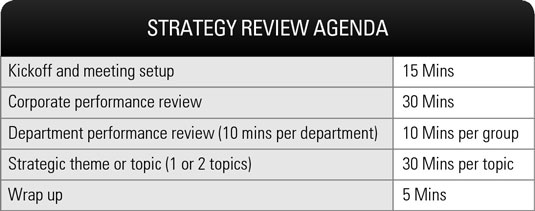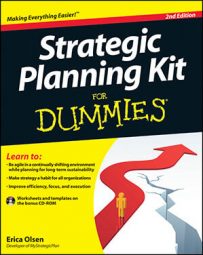Differentiating between a strategy review and an operational review is important. Simply put, an operational review is an in-depth look at the big picture, addressing communication issues, operating procedures, profitability issues, and other factors that affect a business, making it unstable.
A strategy review monitors progress of the company from a strategic level, making sure that the objectives are on track. The table breaks down the differences between strategy and operational reviews even further.
| Strategy Review Meetings | Operational Review Meetings |
|---|---|
| Waypoint level: “highways in the sky” | Runway level: “coming in for landing” |
| Department level conversation about what you’re working on | Keeping everyone in the loop on how your projects are going |
| Review of key performance indicators (KPIs) — are we moving the dial; showing results? | High-level updates on your projects — are we on target? |
| Deep dive into one or two department goals and discuss strategic issues | Escalate issues that require management involvement |
| Take action and adapt the plan | Share travel plans |
| Dept. manager reports out; group discussion/brainstorm | Individual reports out |
Holding regular strategy reviews is key to implementing your strategic plan, making the numbers, achieving your company goals, and, finally, making strategy a habit for everyone involved. These meetings give you the ability to manage activities that drive future results and hold people accountable for making sure that those activities happen. More importantly, these meetings allow you to keep your finger on the pulse of your efforts and make necessary adjustments before it’s too late.
So how do you go from holding just another meeting to making these strategy meetings effective and worth everyone’s time? Check out the following tips:
Schedule the monthly strategy meetings on the same day and at the same time each month. For example, schedule the meetings for the first Tuesday at 10 a.m. every month.
Invite individuals or heads of each department. Ensure the perspectives at the table are diverse and cross-represented.
Make the meeting mandatory — no exceptions. Having the meeting scheduled for the same day and time every month helps attendees work their schedules around it.
Keep presentations to a minimum. Make sure to have a clock or watch in the meeting room, or assign a person to watch the time for agenda items.
Start and end on time and stay on task with an agenda. See the sample agenda in the figure.
The purpose of your meetings is for individuals and department heads to give a quick report on where they stand on the measurements identified on their scorecard. Restrict the meeting to reporting on measurements and nothing else, so you can stay on task and remain within the established limit. By following this process, everyone on the management team knows exactly where the company stands in terms of key measurements.

Here are some guidelines to use as you establish your meeting structure:
Separate strategy reviews from operational reviews. Establish a clear separation by (1) holding them on separate days or (2) making a clean break in the meeting from operations to strategy.
Review strategy on a monthly or quarterly basis. Monthly can seem too frequent for review because strategy, by its nature, is long term. However, quarterly can seem too infrequent and, therefore, strategy won’t be top of mind. The solution is to rotate strategy themes and issues monthly. Review one theme per month, so each theme (if there are three) is visited quarterly.
Use open reporting to promote accountability, transparency, and teamwork. Use goal status and scorecards.
Create issue-oriented meeting agendas. Collect strategic issues from your team ahead of time or revisit those that rolled over from the previous strategy review meeting. Pre-prep the issues in order to facilitate a truly strategic conversation.
If problems arise, convene a separate task force team meeting immediately afterward. Task force team meetings should be kept to a time limit, such as 30 minutes, and include only those people who are directly responsible for the measurements or those who can contribute to resolving the problem.
The primary purpose of this meeting is to brainstorm ideas and give the appropriate department heads some fresh thinking on how to approach the problem. Everyone puts her best ideas on the table, and the manager in charge goes back and decides which ideas to implement. The following month, the department head reports back to the task force team on the actions he took to resolve the issue.

